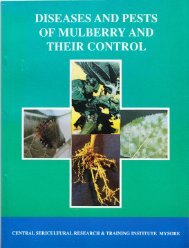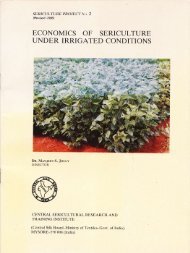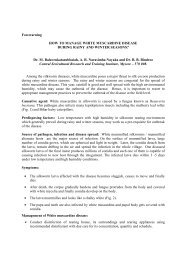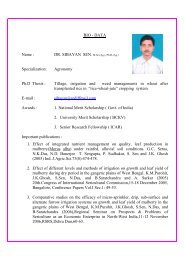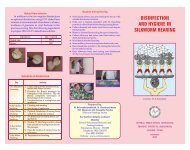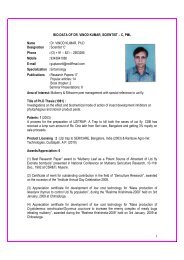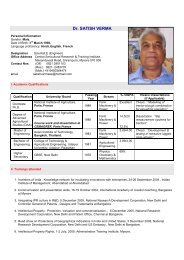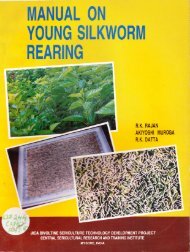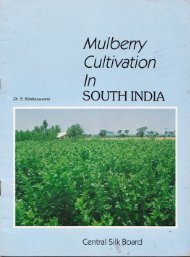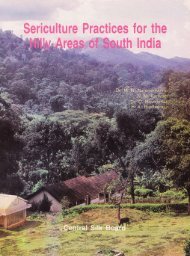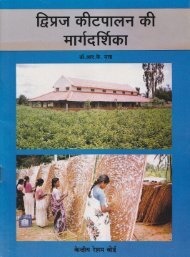E}A]\GALORE
Improved Method Rearing Younf Age (Young) Silkworms - Central ...
Improved Method Rearing Younf Age (Young) Silkworms - Central ...
- No tags were found...
Create successful ePaper yourself
Turn your PDF publications into a flip-book with our unique Google optimized e-Paper software.
IMPROVED METHOD OF REARING YOUNG AGE<br />
(cHAWKr) SILKWoRMS<br />
DN. S. KRISHNASWAMI<br />
DIRECTOR (aeto.)<br />
Central Sericultural Research & Training lnstitute, Mysore<br />
(Reprinted from the Bulletin No. 3 of the C. S. R. & T. 1., Mysore)<br />
CENTRAL SILK BOARD<br />
(Govt. ol lndia- Ministry of Textiles)<br />
E}A]<strong>\GALORE</strong>
Reprint: April-1990 - 5,000 copies<br />
Published by:<br />
Shri P. S. S. Thomas<br />
Member-Secretary<br />
CentralSilk Board<br />
United Mansions<br />
No. 39, Mahatma Gandhi Road<br />
BANGALORE-560 OO1.<br />
Printed at:<br />
Omkar Offsel Printers<br />
Bangalore-560 002.<br />
Phone: 609026/6081 86<br />
Editor:<br />
ShriJ. Sampath<br />
Deputy Director ( Publicily)<br />
CentralSilk Board<br />
Bangalore-560 001.<br />
Price: Rs.3
CONTENTS<br />
Page<br />
I. INTRODUCTION<br />
1<br />
II. CHAWKI REARING<br />
(a) Equipments<br />
(b) Rearing Room Space<br />
(c) Preparation for Brushing<br />
(d) The Egg<br />
2<br />
(i) lncubation<br />
(ii) Black Boxing of Eggs<br />
(iii) Brushing<br />
(e) Quality of Leaf<br />
(i) Chopping of Leaves<br />
(ii) Preservation of Leaves<br />
(0 Ecological Requirements of Environment<br />
(g) Spacing<br />
(h) Feeding<br />
(i) Bed Cleaning<br />
(j) Handling of Young Age Worms during Moult<br />
(k) rssue of Young Age Worms<br />
(l) Rearing of Third Age Worms<br />
III. ADVANTAGES OF CHAWKI REARING<br />
2
I. INTRODUCTION<br />
ln the practice of sericulture, particularly in relation to silkworm rearing, a certain<br />
amount of risk is invariably experienced by sericulturisis. At fairly frequent intervals,<br />
they face cocoon crop losses which may be either partial or total. Often these losses<br />
occur at the last Stages after considerable amount of expenditure has been incurred<br />
by way of leaf utillsed and labour engaged in silkworm rearing. This dampens the<br />
enthusiasm of the sericulturists. Repeated total crop losses may even ruin the<br />
economic stability of Sericulturists, especially those'who depend mainly on silkworm<br />
rearing for their livelihood. ln these circumstances, they appear to be completely at a<br />
loss to know as to what had gone wrong with the rearings and what were lhe lactors<br />
responsible for the large scale mortality of worms that led to such serious crop failures.<br />
The risk to cocoon crop arises mainly from diseases that afflict the rearings.<br />
These fall under the four well-known categories namely the Pebrine, lhe lv'luscardine,<br />
the Grasserie and the Flacherie. ln silkworm rearing,the best method of tackling them<br />
is by taking preventive steps since these steps are easy to carry out. Curative<br />
measures, on the other hand, are only effective in the case of some diseases like<br />
Muscardine. For diseases like Pebrine, Flacherie and Grasserie, effective curative<br />
measures are yet to be devised. l"lowever, alllhe four categories of diseases can be<br />
prevented,if the rearing is carried out according to scientific methods as described in<br />
Bulletin No. 2 of the Central Sericultural Research and Training lnstitute, h4ysore, on<br />
the New Technology of Silkworm Rearing.<br />
The Pebrine occurrence can be avoided by rearing disease free layings and<br />
adoption of systematic disinfection of rearing lrouses and the rearing appliances with<br />
formalin. Similarly, Muscardine can be prevented through manipulation of moisture in<br />
the iearing bed and maintaining it at optimum levels in diflerent seasons. ln the cases<br />
of Flacherie and Grasserie, however, the diseases can be prevented only by raising<br />
vigorous and healthy stock of the worms right from the beginning, starting with the<br />
brushing operations. Worms reared under situations that lead to underfeeding or<br />
conditions of excessive moisture will become easily susceptible to Grasserie and<br />
sometimes to Flacherie as well. lt is in this conlext, rearing of young age worms<br />
becomes very significant. lf and when a healthy and vigorous slock of young age<br />
worms is raised, it will shorv considerable resistance to these two diseases ancl no<br />
problems of mortality in the late ages will be met wiilr.
II. CHAWKI REARING<br />
Tire concept of chawki rearing is not new. ln Japan, the importance of young<br />
age silkworm rearing to raise healthy stock has been fully appreciated. There,<br />
practically the entire quantity of eggs usecJ for raising cocoon crops is first reared in<br />
lully equipped young age rearing centres specially organised for the purpose under<br />
expert technical supervision. Although the sericulturists place their indents for eggs in<br />
terms of boxes of eggs (one box containing aboLit 20,000 eggs or 50 layings), the<br />
indents are supplied as worms after the second or lhird moult. Being very healthy, the<br />
worms spin successful cocoon crops when handled by the sericulturists in the late<br />
ages. This is a very important and significant factor that is mainly responsible for<br />
ensuring successful cocoon crops. Towards this end, very heavy financial investments<br />
have been made by way of suitable buildings, necessary land for mulberry and expert<br />
personnel to guide and conduct the work of young age rearing.<br />
ln lndia too, particularly in Karnataka State, Chawki Rearing Centres (CRCs)<br />
have been organised by the State Department of Sericulture since some time in the<br />
past, but so far, they have not made any perceptible impact on the subsequent rearings<br />
by sericulturists in regard to either yields or quality of the cocoon harvests. This has<br />
been mainly because of the limited lacilities and technical guidance available to these<br />
Chawki Rearing Centres. Since recently, however, with the introduction of the<br />
lmproved Technique of Silkworm Rearing in 1971 by the Central Sericultural Research<br />
and Training lnstitute, there has been a greater awareness as to the needs of suitable<br />
equipments such as rearing boxes or trays, paraffin paper, foam rubber etc. While, no<br />
doubt, this is showing some improved results in the lield now, full benefits from<br />
scientific methods of young age rearings are yet to be realised. lt is, therefore, intended<br />
that this bulletin will provide the necessary technical guidance to all the Chawki<br />
Rearing Centres and also the sericulturists at large in their chawki rearing work. The<br />
need for this bulletin is specially significant in the context of the lntensive Sericulture<br />
Development Programme just launched by the Departments of Sericulture in Karnataka,<br />
Andhra Pradesh and Tamil Nadu under the Central sponsorship of the Central Silk Board,<br />
Government ol lndia.<br />
The technical details of the scientific method of young age silkworm rearing are<br />
described below:-<br />
A. Equipments:<br />
The chawki rearing can be carried out in ordinary rearing trays like the bamboo<br />
'thattes' or wooden trays, but the latter are preferred, since they are more convenient<br />
to maintain humidity and also for handling. The bamboo trays may be ol 3' diameter.<br />
The wooden trays should be of convenient size so that one person can handle it easiiy.<br />
It may of the measurement of 3'x2'x3" in height, as shown in Figure 't.<br />
For every 100 disease free layings,'ten wooden trays of size 3'x2,x3" are<br />
required, and so, for an acre of mulberry garden under irrigation, which can brush upto<br />
2
Figure 1<br />
-<br />
Rearing of, chawki silkworms<br />
A. ln wooden tray<br />
B. ln round bambbo tray<br />
3
250-g0O layings at a time, 25 to 30 trays will be required to do the chawki reartng.<br />
ln the case of dry garden, the requirement will be about 10 trays which will suffice to<br />
do the chawki rearing, upto 100 layings at a time'<br />
ln addition to trays, stands or racks are also required so that the trays containing<br />
worms which are normally kept piled up one over the other, may be spread out on the<br />
stands for short periods for necessary drying of the beds prior to each feeding' A bench<br />
is also required which is used as the base for piling up the trays.<br />
The rearing stands meant for normal rearing of late age worms may be used for<br />
spreading the trays for drying purposes. ln the case of Government owned or assisted<br />
chawki rearing centres or community chawki rearing centres, where a large quantity<br />
of eggs is brushed for young age rearing and distribution of chawki worms to the<br />
sericulturists later, it is important that they are properly equipped as indicated above<br />
to ensure eflicient working and production of good results'<br />
B. Rearing Room SPace:<br />
lf one can afford, it is always desirable and convenient to have a separate<br />
chawki rearing room or house, so that chances of contamination from the debris of the<br />
main rearing house, where the diseases normally manifest themselves, are kept at<br />
minimum. lt will also facilitate easy disinfection of the chawki rearing house as and<br />
when required, quite independently of the main rearing house. Further, the space<br />
required lor young age rearing being comparatively smaller and limited, the desired<br />
temperature level for the young age worms could be easily attained and maintained<br />
even in cold weather.<br />
The rearing room space required for young age rearing will depend on the area<br />
of the mutberry field and its leaf yielding capaciiy. From one acre of irrigated garden,<br />
that is cultivated on scientilic lines as recommended in Bulletin No. 1 of the lnstitute,<br />
it is possible to get upto'10 to 12 thousand kg. of quality leaf per acre per annum' with<br />
these, as many as 1,250 to 1,400 layings can be reared, the leaf used being at the<br />
rate of 800 to 850 kg. for every 100 layings as recommended in Bulletin No' 2 of the<br />
lnstitute. This would mean that on dn average 250 to 300 layings can be reared at a<br />
time per rearing, out of the five rea:'ings in all that can be taken lrom an acre' On the<br />
basis of above reckoning, chawki room space required for an acre ol irrigated mulberry<br />
garden is about 10'x1i'o, 120 sq. ft' which is needed to accommodate about 30<br />
trays, one stand or rack and a bench.<br />
The rearing room should have optimum sized windows with shutters provided,<br />
preferably on all sides of the room, so that inside ventilation could be manipulated as<br />
required.<br />
The rack and the trays may be arranged in the (10'x12') room as indicated in<br />
Figure 2.
v<br />
Ir;<br />
ro'<br />
I'<br />
D<br />
l2'<br />
Figure 2 - Rearing Room Space and Arrangement of chawki Rearing Trays, Stand and Bench.<br />
A. Rack: 7' x 21lc' x 71lz'tall (10 tiers)<br />
C. Bench; 6' x21/a' x1' lall<br />
B. Tray : 3' x 2'x 3" height<br />
D. Door W. Window<br />
The trays numbering about 30 can be arranged one over the other upto 10 tray<br />
height in blocks on the bench, the legs of which are mounted on ant-wells as shown<br />
in Figure 3. ln fact, the bench can accommodate upto 45 trays, i.e., to a height of 15<br />
trays in each block. ln that case, upto 450 layings at a time can be reared in this<br />
10'x12' room and therefore, this room space can manage even upto 11/a oGros of<br />
irrigated mulberry. However, even lor one acre, this much room will be found<br />
necessary.<br />
Similarly, corresponding to the increased brushing capacity, there will be<br />
corresponding reduction in space required per unit of layings brushed. What is<br />
important to remember in this respect is that sufficient space should be provided for<br />
trays to be arranged in blocks upto a height of 10-15 trays,.piled one over lhe other<br />
on the benches (with adequate spacing jn between the benches) and for the required<br />
number of stands to be placed inside.
t'<br />
I<br />
Figure 3 -<br />
Piling Up of The chawki Rearing Trays on the Bench.<br />
A. Paraffin paper B. Ant well.<br />
A chawki rearing room of 10'x12'dimension can command upto 4-5 acres at<br />
a time in the case of dry mulberry gardens, since the leaf yield even under the<br />
improved methods of cultivation is only about a quarter of that of the irrigated garden.<br />
lf a separate chawki room cannot be afforded by any sericulturist, he may still<br />
carry out his chawki rearing in any suitable place in his dwelling house, wher:e the<br />
temperature fluctuation should be as low as possible and where it would be possible<br />
to raise and maintain temperature at the required level, particularly during the<br />
cold weather.<br />
G. Preparation for Brushing:<br />
As described in Bulletin No. 2 entitled "New Technology of Silkworm Rearing",<br />
the rearing of young age silkworms should be commenced only after due disinfection<br />
of the rearing house or the room and all the rearing appliances with 2 per cent Formalin<br />
solution.<br />
6
D. The Egg:<br />
It need hardly be emphasised that the quality of eggs to be used in rearing is<br />
a very important factor determining the success of rearing. Good quality eggs, free from<br />
diseases, ensure bumper yields of quality cocoons, that fetch good prices. They are<br />
characterised by the richness in regard to number of eggs in the laying, which snould<br />
contain about 400 eggs normally. Further, in good quality layings, the eggs are<br />
generally bold, plump-looking, containing comparatively a greater amount -of yolk<br />
material. This helps to give the newly hatched larva a good initial start in regard to its<br />
health, vigour and growth.<br />
A further index of good quality is reflected by the urriformly rich layings on the<br />
egg sheets, which contain normally 20 layings, with minimum of rejection due to either<br />
poor egg number or diseases. This indicates that the eggs have been prepared from<br />
a batch of healthy seed cocoons that has been reared without any disease afflictions<br />
and therefore, can ensure for healthy next generation eggs.<br />
(i) lncubation: once quality tayings have been procured, it should be the<br />
endeavour to ensure that they are properly preserved and incubated so that best<br />
results of hatching and final cocoon harvest are obtained. Every care should be taken<br />
to see that the eggs are not exposed to excessive heat or dryness during transit. For<br />
safe protection and preservation of the eggs, the ideal conditions required are about<br />
25"C temperature and about 80 per cent relative humidity. Therefore, the egg sheets<br />
should be spread out in a single layer in rearing trays and covered with either paraffin<br />
paper (preferably) or even ordinary newspaper. Should the atmospheric humidity fall<br />
below 70 per cent R.H., wet paper or wet foam rubber band may be kept all round the<br />
egg sheets and then covered with paraffin paper. The trays containing eggs should be<br />
stored in as cool a place as possible in the dwelling house or rearing house, where<br />
the atmospheric temperature fluctuation is minimum.<br />
When eggs are incubated as described above, the development of the embryos<br />
takes place uniformly and very uniform hatching of eggs will result. During incubation,<br />
it is very important to remember that eggs should not get affected due to desiccation<br />
resulting from low atmospheric humidity. Therefore, every care should be taken to<br />
maintain humidity around 80 per cent.<br />
(ii) Black boxing of eggs: ln order to ensure that hatching of eggs upto gO to<br />
95 per cent takes place at a time, 'black boxing of eggs' may be resorted to as a<br />
very useful step. This may be followed as described below:<br />
About 48 hours before hatching, the embryo reaches the 'Pin head' staEe and<br />
about 24 hours prior to hatching, it attains the 'Blue egg' stage. During this period, the<br />
egg sheets should be put inlo convenient card board box or wooden box and wrapped<br />
up in either black piece of cloth or black sheet ol paper. Then they should be left<br />
undisturbed for 48 hours or 24 hours depending on the stage of development at which<br />
'black boxing' was resorted to. This will enable practicaily all the developing embryos<br />
to attain full and uniform growth without hatching.<br />
4
On the expected date of hatching, (which is normally between 9 to 12 days after<br />
egg laying, depending on the seasonal temperature conditions), as indicated by the<br />
presence of a few hatched larvae on the egg cards, the 'black boxed eggs' should be<br />
exposed suddenly to bright day light between 8 a.m. and 9 a.m. The photo stimulus<br />
thus provided will ensure over 90 to 95 per cent hatching in about one to two<br />
hours time.<br />
(iii) Brushing: lmmediately after the young worms hatch out of the egg sheets<br />
to an extent of more than 90 per cent, which should normally be achieved within about<br />
one to two hours or so, the newly hatched worms should be fed and brushed on to<br />
the rearing beds. 'As the hatched worms start dispersing from the egg sheet, they<br />
should be sprinkled over with freshly chopped tender leaves cut into bits of 0.5 to 1<br />
cm. squares. After all the hatched larvae have crawled on to the chopped leaves, the<br />
leaves alongwith the larvae should be gently brushed into the rearing tray with the help<br />
of a feather. The few larvae left over on the egg sheets may be dislodged from the<br />
sheets to the rearing bed by gently tapping the sheets. lt is important to remember that<br />
the newly hatched worms should not be starved for unduly long periods, which will<br />
result in the worms getting weakened due to starvation.<br />
Soon after brushing, the rearing bed should be made up, if necessary by giu'ng<br />
some more chopped leaf and covered with paralfin paper. When the atmospheric<br />
humidity is low (say below 7O%), wet paper or wet foam rubber band should be<br />
invariably kept around the rearing bed to provide necessary humidity required by the<br />
young worms.<br />
E. Quality of Leaf :<br />
It need hardly be emphasised that the main object of taking special efforts to do<br />
the chawki rearing is to raise robust, healthy and vigorously growing stock of young<br />
age worms so that they may not easily succumb to adverse climatic and other disease<br />
factors in the late ages, but ensure a high effective rate of rearing, resulting in bumper<br />
harvest of cocoons' This can be achieved only by feecling the young age worms with<br />
highly nutritious leaves in adequate quantities and at suitable intervals of time.<br />
Researches carried out in this regard have established that the top two to three full<br />
blown leaves immediately below the growing bud, are highly nutritious from the point<br />
of view of growth requirements of the young silkworm larvae, since they are<br />
comparatively richer in proteins, soluble sugars and carbohydrates, which are essential<br />
for vigorous growth of silkworms. Such quality leaves are tender, succulent and dark<br />
green in colour' with a pleasing shine on them. These should be plucked and fed in<br />
as fresh a state as possible after due chopping, to commence the rearing and also continue<br />
with the first age worm rearing. As the worms grow, progressively less and less<br />
tender leaves should be used for feeding them.<br />
Quality leaves as described above can be had only from mulberry fields that are<br />
cultivated according to improved methods recommended in Bulletin No. 1 of the
lnstitute. The mulberry fields should receive adequate quantities of manures and<br />
fertilisers and irrigation where required. ln advanced countries like Japan, special<br />
mulberry gardens are raised for chawki rearing purposes.<br />
(i) Chopping of Leaves: Since the worms in the young ages are tiny in size,<br />
necessarily chopped leaves have to be used to feed them so that the leaves could be<br />
spread uniformly over the worms in the bed and the worms also can have ready and<br />
easy access to the leaves. lt also assists in loosening and spreading the bed when the<br />
bed is required to be dried prior to leeding and also at the time of moulting. Tlre<br />
traditional practice is to cut the leaves rather too finely into almost shreds of leaves.<br />
Such finely shreded leaves tend to dry too fast, necessitating too many feeds and at<br />
too frequent intervals. Therefore, this practice should be given up. lf the leaves are<br />
chopped into too big pieces or used as entire leaves without chopping, the larvae tend<br />
to get over-crowded in localised spots which again is not desirable for free and lull<br />
growth of larvae. lt is, therefore, important that the leaves should be cut to optimum<br />
size at every staEe of the growth of the worms.<br />
To start with, the chopping should be fine to obtain pieces of 0.5 to ,1 cm.<br />
squares which can be gradually raised to 1'5 to 2 cm. squares by the end of firp'i instar<br />
i.e., over a period of 3 to 31/z days. Similarly in the second age, the leaf size is started<br />
as 2 cm. squares and increased to 3 to 4 cm. squares by the end of the second instar.<br />
Towards the close of every instar, i.d. just prior to the worms entering into moult, one<br />
or two feeds are given as final cover feed for lhe instar and these arJinvariably given<br />
with slightly reduced size leaves, ie., about 1 cm. squares for the first instar and about<br />
11lz lo 2 cm. squares for the second instar.<br />
(ii) Preservation of Leaves:As already emphasised in Bulletin No.2 of the<br />
lnstitute of the New Technology of Silkworm Rearing, preservation of leaf, following<br />
plucking, in as fresh a state as possible till it is fed to worms and consumed by them,<br />
is a very essential requirement to ensure successful crops. This applies with lreater<br />
emphasis for the chawki rearing stage as well. Tender leaves plucked lrom the larOen<br />
should be brought to the rearing house in covered containers like baskets or covered<br />
in wet gunny cloth. Leaves should be plucked invariably during the cooler hours of the<br />
day, either early in the morning or late in the evening and immediately preserved in<br />
suitable containers like leaf bins, where the humidity must be maintained close to 1OO<br />
per cent R.H. by repeated sprinkling or spraying of water over the gunny or cloth<br />
surface of the container. lf containers are not available, they should be atleast covered<br />
with wet cotton cloth or gunny cloth. The cloth used to cover leaves should be clean<br />
as far as possible.<br />
Although leaf preservation may be adopted systematically as recommended here,<br />
quite often sufficient care is not bestowed to maintain the freshness of leaves at the<br />
time of chopping of leaves. The leaves are left exposed due to negligence either prior<br />
to chopping or following chopping with the result the leaf loses moisture and<br />
consequently, the freshness and quality. The chopped leaves which are cut small for
leeding the chawki stages dry rather quickly, if left exposed. Therefore, the chopped<br />
leavejshould be collected in plastic or metallic basins or buckets and should be kept<br />
covered, Proper preservation of chopped leaves is also highly essential and every care<br />
should be paid to this important aspect.<br />
During the rainy seasons, however, the leaves are replete with excessive<br />
moisture. Similarly, the atmospheric humidity is also comparatively higher, and<br />
therefore, the drying of leaves due to exposure does not present much of a problem<br />
of preservation. Hence, the special care required to preserve the freshness of leaves<br />
during normal seasons or Summer season may not be found necessary' On the other<br />
hand, if the teaves are wet with droplets of rain water physically present on the surface<br />
of leaves, they may have to be spread out in thin layers, so that the excess moisture<br />
present on the surface may evaporate away'<br />
F. Ecological Requirements of Environment:<br />
It has been scientifically established that early instars of silkworms show<br />
best growth under ideal condittons of temperature around 27"c and rglative<br />
humidity around 90 per cent. Therefore, in order to procure best growth and<br />
consequently a robust batch of young age worms, rearings should be conducted in<br />
environmental conditions as close as possible to the above ideal' By environment, the<br />
immediate vicinity of the worms is meant, i.e., the rearing bed envtronment' The<br />
,requirements of environment can be achieved to a large extent by resorting to young<br />
age worm rearing in suitable container trays. Wooden trays measuring 3'x 2' and 3"<br />
in height are suitable for the purpose.<br />
The required humidity is secured by rearing the young age worms in between<br />
paraffin papers which are used as base for the rearing bed at the bottom of the tray<br />
and as a cover over the rearing bed. When the atmospheric humidity fall low, say below<br />
70 per cent, wet paper or wet foam rubber bands should be placed around the rearing<br />
bed in between paraffin papers to increase the humidity of the rearing bed. As a further<br />
precaution to maintain optimum humidity and temperature, the rearing trays are piled<br />
one over the other upto a convenient height (10 to 15 trays) as shown in Figure 3'<br />
The top-most tray should be a dummy trav without the worms.<br />
During rainy seasons, however, the atmospheric humidity will be high and so<br />
also the moisture content in the leaves. Therefore, quick withering of leaf is not<br />
experienced. On the other hand, these factors will tend to increase the bed humidity<br />
beyond 90 per cent. Under such circumstance, it will not be necessary to use paraffin<br />
p"p"r at the bottom of the rearing bed or the wet paper or wet foam rubber bands<br />
beiween the paraffin papers. Should the humidity be close to 100 per cent (as during<br />
days of continuous rain), the piling of the trays one over the other may also be<br />
dispensed with. lt may be found even desirable to delay the covering of the rearing<br />
bed with paraffin paper for some time (about 15 tO 30 minutes) after feeding, so that<br />
some of the excessive moisture present in the leaf could evaporate'<br />
10
Thus, it is important to ensure that the bed humidity is kept between 80-90 per cent<br />
and for this, necessary manipulation, as indicated above, rs very essential. Otherwise,<br />
disease problems are bound to arise. lf the bed humidity is high-beyond g0 per cent,<br />
the worms will automatically become susceptible to Grassarie as well as Muscardine<br />
diseases. And, if the humidity falls below 80 per cent, the leaves will tend to dry fast,<br />
leading to undernourishment and the resultant weakening of worms, as indicated by<br />
slow growth and prolonged larval instar, inspite of optimum temperature conditions.<br />
The temperature of the room should be maintained at aboul 27"C by suitably<br />
manipulating the doors and windows of the room during different parts of the day and<br />
allowing better aeration of the room when the temperature and humidity go beyond the<br />
tolerance limit as indicated in Bulletin No. 2 of the lnstitute. When the temperature falls<br />
below 25'C, the rearing room should be artificially heated using an electric heater'or<br />
a smokeless charcoal fire inside the room sci as to bring up the temperature to the level<br />
ol 27"C.<br />
The maintenance bf humidity and temperature as indicated above willensure fast<br />
and vigorous growth of the worms uniformly.<br />
G. Spacing:<br />
ln the Bulletin No. 2 on the "New Technology of silkworm Rearing", the<br />
importance of optimum spacing of thb worms in rearing beds has been adequately<br />
stressed. This constitutes an essential technical consideration for successful harvest of<br />
bumper cocoon crops. This applies with greater emphasis to the rearing of young age<br />
silkworms. Through optimum spacing at every stage of rearing, starting from brushing<br />
of the worms, vigorous growth, robust health and uniform development of the entire<br />
batch of worms are ensured (as shown in Figure 4).<br />
Experimental studies in this regard have established that the optimum spacing<br />
for young age worms in their first two instars is as follows for 100 layings which contain<br />
an average of aOO eggs per laying:<br />
Age of the Area of the rearing bed lncrease in spacing<br />
worm At the beqinninq At the end<br />
the instar<br />
4 sq. ft<br />
15 sq. ft<br />
14 sq. ft<br />
45 sq. ft<br />
31/z times<br />
3 times<br />
ln actual practice where 3'x2'x3" trays are used for chawki rearing, as<br />
recommended earlier, it is convenient to rcar a certain number of eggs in one and the<br />
same tray till the second moult is passed. Therefore, 100 layings should be brushed<br />
in 10 trays at the rate of 10 layings per tray (measuring g,x2'x3,,). ln that case, the<br />
spacing to be adopted in each tray will be as described further.<br />
11
Figure 4 - Spacing of Chawkr Srlkwc_.rrnrs jn il.re tlealnq b]€rcl<br />
A. Overcrowded<br />
12<br />
B. Optlmum
1st lnstar<br />
At the time of brushing<br />
At the end of 24 hrs. (1 day)<br />
At the end of 48 hrs. (2 days)<br />
At the end of 72 hrs. (3 days)<br />
(ln the next 12 hrs., the worms will settle for first<br />
Area of the bed<br />
. 6"x 9"<br />
9"x12"<br />
12"x12"<br />
12" x18"<br />
moult-Figures 5 & 6)<br />
,'<br />
A.<br />
c<br />
E.<br />
At the time of brushing (6"x9")<br />
At the end of 48 hours (12"x12")<br />
Paraflin paper<br />
Figure 5-Spacing for Firsi<br />
Age Worms<br />
B. At the end ot 24 hours (9,x12,)<br />
D. At the end of 72 hours (12"x19,,)<br />
F. Foam rubber band<br />
13
Ftgure 6 -Optimum Spacing for First Age Worms in (3,x2,x3,,) Wooden Tray<br />
(10 Layings per Tray)<br />
A. ln the beginning (6,,x9,,)<br />
B. At the end (12,,xt8"r
Figure I -Optimum<br />
Spacing for Second Age Worms in Wooden Trays<br />
A. ln the beginning (1, x 1t/2,).<br />
16 B. At the end (13/4, x 21/z')
Some people are already using wooden trays of size 4'x3'x 4". ln such large<br />
size trays, only 25 layings should be brushed per tray, for rearing the worms upto<br />
second moult. ln other words, 100 disease free layings containing about 40,000 eggs<br />
should be brushed in four trays and not in one or two trays as hitherto being practised.<br />
ln such cases, using 25 layings pertray, the spacing to be adopted will be as follows:<br />
l st lnstar<br />
At the time of brushing<br />
At the end of 24 hrs. (1 day)<br />
At the end ol48 hrs. (2 days)<br />
At the end of 72 hrs. (3 days)<br />
Area of the bed<br />
12"x12" or 1'x1'<br />
15"x18" or 11lt'x11lz'<br />
18"x21" ot 11lz'x131+'<br />
1 8" x 30" or 11lz' x2l lz'<br />
(ln the next 12 hrs., the wo,rms will settle for first moult)<br />
2nd lnstar<br />
Area of the bed<br />
At the time of resumption of feeding<br />
At the end of 24 hrs. (1 day)<br />
At the end of 48 hrs. (2 days)<br />
1 8" x 30" or 11lz' x21lz'<br />
30"x36" or 21lz'x3'<br />
36" x 45" or 3'x 33/+'<br />
(ln the next 12 hrs., the worms will settle for second moult-Figures 7 & 8)<br />
Those who cannot afford wooden trays and who would like to use bamboo round<br />
thattes of 3'diameter may brush upto 15 layings per tray and adopt spacing as<br />
indicated below:<br />
l st lnstar<br />
At the time of brushing<br />
At the end of 24 hrs. (1 day)<br />
At the end of 48 hrs. (2 days)<br />
,At the end of 72 hrs. (3 days)<br />
(ln the next 12 hrs., the worms will<br />
2nd lnstar<br />
Area of the bed<br />
9"x9" o( 3/+'xal+'<br />
12"x12" ol 1'x1'<br />
15"x 15" or 1llq'x11lc'<br />
18"x18" or 11lz'x11lz'<br />
settle for first moult-Figure 9)<br />
Area of the bed<br />
At the time of resumption of feeding<br />
At the end of 24 hrs. (1 day)<br />
At the end of 48 hrs, (2 days)<br />
18"x18" of 11lz'x1llz'<br />
24"x27" ot 2'x21/c'<br />
Spread to cover the<br />
entire tray area<br />
(ln the next 12 hrs.,the worms will settle for seconcj moult-Figure 10)<br />
17
Figure g<br />
-<br />
Optimum Spacing for First Age \t/orms rn Round Bambor.r Trays<br />
(3' Diameter) (15 Layings per Tray)<br />
A. ln the beginning (9,, x9,).<br />
18<br />
B. At lhe end (18,, xlB,,)
Figure 10-Optimum Spacing for Second Age Worms in Round Bamboo Trays.<br />
A. ln the beginning (18' x 18')'<br />
B. At the end (Full Tray).<br />
19
It may be seen from the above that spacing' is required to be increased<br />
systematically at every stage of growth of the chawki worms. For example, in the case<br />
of 3'x2' x3" wooden tray with 10 layings brushed, the spacing is increased from a bed<br />
size of 6"x9' to that of 9"x12" over a period of 24 hours from the time of brushing.<br />
This is achieved gradually by increasing the spacing at every feed during lhe24 5ours.<br />
period' ln this way, spacing is increased every day of the rearing. The object in doing<br />
so is to ensure maximum development of all the larvae .uniformly by providing required<br />
space as they grow. Further, it helps to keep the bed thin (i.e., less than 1/2,, in height)<br />
and this assists in the drying of beds prior to every feeding. lt is well to remember here<br />
that thick beds, which cannot be dried easily and which tend to build up bed humidity<br />
beyond 90 per cent will lead to the outbreak of Muscardine and Grasserie diseases.<br />
H. Feeding:<br />
As already pointed out in Bulletin No. 2 on the 'New Technology of Silkworm<br />
Rearing', the young age silkworms are led thrice or four times during fhe day<br />
depending upon the seasonal weather conditions. ln wet weather, when the<br />
atmospheric humidity as well as moisture content in the leaf are on the higher side,<br />
only three feeds need be given at 6 a.m. 1 p.m. and B p.m. During othei seasons<br />
including summer months, however, four feeds may be found necessary, which may be<br />
given at 6 a.m., 11 a.m., 3 p.m.and B p.m. As regards the quantity of leaf to be fed<br />
to the chawki worms, it has already been indicated (Bulletin No. 2) that the leaf<br />
requiremenl for 100 layings (with average of 400 eggs per laying) during the first age<br />
will be about 2 to 2'5 kg. for the improved multivoltine hybrids and about 2.5 to 3 kg.<br />
for the new bivoltine hybrids. For the second age worms, the leaf requirement will be<br />
6 to 7 kg. for the improved multivoltine hybrids and 8 to 9 kg. for the new bivoltine<br />
hybrids.<br />
ln the case of rearing ol chawki worms, great care and attention have to be<br />
given to the method of feeding as well, in addition to the correct way of chopping,<br />
optimum quantity of feed, number of feedings to be given etc. Unless the correct<br />
method of feeding is adopted, the oblectives of chawki rearing, namely raising of<br />
vigorously growing larvae of robust health and unilorm development will not be fully<br />
realised. The correct method of feeding is described below:<br />
lmmediately after brushing, the rearing bed is made up, with due spacing<br />
prescribed (as already described) and covered with paraffin paper. lf required, the wet<br />
paper or wet foam rubber band is placed around the rearing bed in between the paraffin<br />
paper sheets. The trays are later piled up one over the other to a convenient height.<br />
Thereafter, prior to every feeding that is to follow, the procedure described hereunder<br />
should be meticulously adopted.<br />
Half an hour prior to feeding, the paraffin paper cover should be removed and so<br />
also the wet paper or wet foam rubber band from the tray. Then the tray is placed on<br />
20
?2r+<br />
Figurell-ArrangementolChawkiRearingTraysontheStand(Rack)<br />
the rearing racks or stands (as shown in Figure 1 1) so that the bed along with the<br />
unconsumed leaves may dry sufficiently. lf need be, the bed may even be slightly<br />
opened up by spreading the chopped leaves in the bed further with the help of feathers<br />
to facilitate quick drying of the bed. ln about half an hour's time, the entire bed would<br />
have almost dried. The young worms are also enabled to drive out excessive moisture<br />
from their body. After the bed is dried alongwith the unconsumed bits of leaves present,<br />
feeding with fresh chopped leaves is resumed. At that time, it should be ensured that<br />
the worms are uniformly distributed over the bed aiea. lf worms are overcrowded in<br />
spots, they are removed with the leaf and redistributed uniformly. Later fresh chopped<br />
leaves are spread thinly (not more than one or two layers in thickness) over the dried<br />
bed without any uncovered gap. Then the bed is made up to the prescribed area, wet<br />
foam rubber band put around and closed with paraffin paper. Later the trays are finally<br />
piled up on the bench one over the other'
when feedi'g is carried out as per the above method, the worms are enabred<br />
to feed always on fresh leaves in one layer, right at tne iip ot the bed. Thus, the worms<br />
are exposed to one environmental corrdition, ano no *orr rurks behind or feeds at<br />
lower levels deep in the bed' rni.<br />
"nrurus<br />
uniform.and hearthy Erowth of the entire<br />
batch of worms, and such worms wilr arso settte unirorr,y ro,. mcurting.<br />
t. Bed Cteaning:<br />
Periodically,as the worms grow in size<br />
accumulation<br />
and as the<br />
builds<br />
dry reaves<br />
up, cleaning;of<br />
and faecar the<br />
matter<br />
carried<br />
;;; ;il<br />
out<br />
li*il<br />
once.in necessary.<br />
the first This<br />
insiar just is usuary<br />
prior to the worms setring for first mourt, say<br />
around 60 to 72 hours from the time of brushing. rn g,"<br />
""re<br />
of second instar the bed<br />
cleaning is carried out two tit"s,-on-." at the time of resumption of feed for the second<br />
il:fl Xii;fiJ ,',?1,'Xi,*rlilililj::ff"ink:lilT,Tt ,ou*1,<br />
"no "s"i;<br />
too,, ,,<br />
Bed cleaning- should always be carried out as foilows: creaning nets shourd<br />
3"ffit'J"t: ffi,$1l;,:,"i*,;il3J,". in the case or<br />
'rawri<br />
rearinEl rne net size<br />
31/z'x{t1r,, o"p"noing on whether it i."t"u of the rearing tray, anoui 21/zlx31/2, or<br />
li<br />
"1, tJ : # d; ;" r #: Til Jji<br />
;."i ; :; i i,?';J,,:? :ffi<br />
",<br />
:: n:l m:;;?1:<br />
when it is inlended to carry out bed creaning, the net is uniformry spread on the<br />
::?:::'T"'J:::iT;J";"'iff' 3# l1?-:"1'n"" 'ioooJd reaves "'" t"o "nl "s"in<br />
is done no'*"rry in 5 to 6 nou,., tir-",:,ii1"ffffi,?,i# [:: il:,.,rff**:Tf<br />
removed carefuily with the net fuily stretched and prJced on ,o<br />
"<br />
new rray. when next<br />
cleaning becomes due, another nlt-i.-rr"d once'again wer tne one arready in use.<br />
Thus' through the use of net for creaning, nanorinf'ot'#r, by hand is compretery<br />
avoided and chances of contamination rrom oiseaJe, nr"-"r,, reduced. Again by this<br />
method of cleaning' almost the entire batch of rarvae ;;1" successfuily transferred<br />
ll:}ff ;r'i"ffi<br />
to the new bed *itnort anv serious ross or the worms durins rhe<br />
It must be remembered in this connection that heavy ross of worms occurs during<br />
the moulting process-and the tr"unrg operations under the traditionar system of<br />
chawki rearing, amounting to over es-iir pe, cent of tne iatcneo worms. Further, ross<br />
due to mortaritv in rarer<br />
"g".<br />
*iir;.;'be higher, il;d;l ross amounting ro over<br />
22
50 per cent quite often. Under the improved method suggested here, the loss of worms<br />
during chawki rearing is minimum, which is less than 10 per cent or so. Again, these<br />
worms being more robust, the mortality at their later ages is also considerably less and<br />
consequently, the total loss of worms is also minimum, which may be of ihe order of<br />
15 to 20 per cent only, thus ensuring 80--85 per. cent effective rate of rearing from the<br />
actual number of worms brushed at the time of hatching.<br />
J. Handling of Young Age Worms during Moult:<br />
As already indicated in the earlier Bulletin (No. 2), the early stage worms sho'"",,<br />
vigorous growth, if they'are provided with optimum temperature and hurnidity conditions<br />
and also necessary spacing and leaf feed. Then they will attain maximum growth in<br />
minimum of time and will take 3 lo 31lz days in the first instar and 21lz lo 3 days in<br />
the second instar to go into moult. ln order to ensure uniform moulting of lhe worms,<br />
settling ol worms for moult should be anticipated and carefully watched for. As signs<br />
of moulting are observed and as soon as a few worms have settled, every effort should<br />
be made to assist the moulting by gradually drying the rearing bed. The piled up trays<br />
are spread out on the rearing stands and then paraffin paper used to cover the bed<br />
as also the wet paper or wet loam rubber bands are removed. Feeding,however, is<br />
continued with reduced quantities and in later stages with somewhat linely chopped<br />
leaves until over 90 per cent of the worms settle {or moulting. This is normally achieved<br />
within about 6 to 8 hours over a period of next two or three feeds.<br />
The worms under moult take about 20 hours to complete moulting from the time<br />
of last leeding and therefore, in aboul 20-24 hours over 90 per cent of the worms<br />
would come out and, it would be time to resume feeding.<br />
It need be hardly emphasised here that worms in rnoult should not be disturbed<br />
at all and that there should be adequate.ventilation during moulting.<br />
The first {eed, after the worms come out of the moult, is given only when over<br />
90 per cent have come out of the moult. lt is always carried out over the net and the<br />
cleaning of the bed is followed within 2 hours of the second feed. By this time, practically<br />
all the worms would have crawled on to the new feed over the net and hardly<br />
any worm will be left behind. lf their number is small, these larvae may be rejected,<br />
if they are more than 5 per cent they may be separately collected by repeating the .net<br />
feeding after some time. The first one or two feeds are invariably given with<br />
comparatively more tender leaves than the one normally meant for the age.<br />
K. lssue of Young Age Worms:<br />
Young age worms reared in special chawki rearing centres are normally issued<br />
in the third instar stage, i.e., afler the second moult. lt is always desirable to issue the<br />
chawki reared worms when it is about one day old by which time, the young worms<br />
would have received at least four feeds and gained suflicient growth and strength to<br />
23
stand transport over distances. lt is also advisable that the worms are transported<br />
during the cooler hours of the day either early in the morning or late in lhe evening<br />
so that no damage due to heat rnay be carrsed to them.<br />
L. Rearing of Third Age Worms:<br />
Third age worms coming out of the second moult are also considered sometime<br />
as young age worms. This age is in fact an intermediate stage between ihe young age<br />
and late age worms and differs in its rearing from the other two. During the third age,<br />
the humidity in the bed should be slightly lower, say about B0 per cent, and for this<br />
the silkworms are reared only under the paraffin paper cover, but without any paraffin<br />
paper at the base. The use of any .wet paper or wet loam rubber bands is also<br />
dispensed with. tf, inspite of this, the humidity is high, even the top paraffin paper may<br />
be removed for short periods to bring down the bed humidity.<br />
From the third age onwards, the worms can be reared in wooden trays or round<br />
bamboo trays mounted on rearing stands.<br />
III. ADVANTAGES OF CHAWKI REARING<br />
The object of organising special rearing units to raise young age silkworms is<br />
to ensure healthv batch of vigorous growing robust silkworms 'trrat wittipin successful<br />
cocoon crops in later stages witir minimum of loss due to diseases and other adverse<br />
conditions of weather. lt has been established through experimental studies thar it is<br />
pcssible to avoirj crop failures to a large extent, if sufficient care and attention is given<br />
fo rearing of young age worms according to scientific methods described in this<br />
Bulletin. Thus, the speciar steps taken to do the chawki rearing to go a rong way in<br />
stabilising cocoon crops, which are traclitionally known to suffer on un<br />
"u"r"j"<br />
at lhe<br />
rate of one out cf every three or four crops Besides saving the cocoon .rop.l chawki<br />
rearing also heips to reap bumper harvest of cocoons in thl region of 45 to 55 kg. per<br />
"100 layings resr:lting from very much improved effective rate of rearing J"i*"*')o-go<br />
per cent and arso much higher cocoon weight ranging between 1.7 ro 2.0 gm. The<br />
cocoons of such bumper harvests are also superior in quality and,therefore, fetch much<br />
higher prices in markets. Bunrper harvests of cocoons resuliing from scientific methods<br />
of chawki rearing will also mean most efficient use of reaf harvests. ln other words,<br />
by using about 800 kg. of leaf for rearing 100 layings, a cocoon yield of 45 ro 50 kg.<br />
can be obtained, which works out 10 a reaficocoon ratio of 1g to 16:1.<br />
Thus, il may be seen that scientific method of young age silkworms rearing is<br />
a major step rn the New Technology o{ Silkworm Reiring.<br />
{tro)ar$<br />
24


![E}A]\GALORE](https://img.yumpu.com/54052619/1/500x640/eagalore.jpg)

